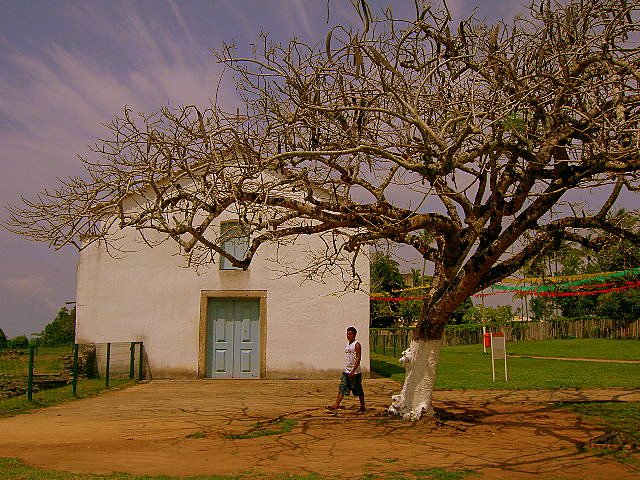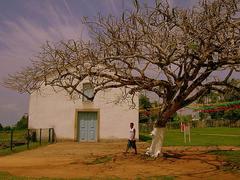
Capela de São Benedito Porto Seguro: Visiting Hours, Tickets, and Travel Guide
Date: 14/06/2025
Introduction
The Capela de São Benedito, located in the heart of Porto Seguro’s historic center, is a profound symbol of Afro-Brazilian faith, resilience, and cultural identity. Erected in the 18th century by Afro-Brazilian communities—including both freed and enslaved individuals—the chapel is dedicated to Saint Benedict (São Benedito), a figure revered for his association with protection and liberation. This modest, whitewashed structure with blue trim stands in contrast to the grander colonial churches built by Portuguese settlers, reflecting the ingenuity and agency of its founders. Today, the Capela de São Benedito is not only a site of worship but a living center of cultural preservation, social cohesion, and spiritual affirmation for Porto Seguro’s Afro-descendant population.
This guide provides essential information on the Capela’s visiting hours, ticket access, guided tours, cultural events, and practical travel tips. Whether you are a history enthusiast, cultural traveler, or spiritual seeker, the chapel offers a rich window into Porto Seguro’s diverse heritage (Instituto do Patrimônio Histórico e Artístico Nacional; Bahia Turismo; Portal Afro; tmatic.travel).
Contents
- Historical Background
- Origins and Construction
- Role in Afro-Brazilian Communities
- Place in Porto Seguro’s Black Heritage
- Architectural Features and Preservation
- Cultural and Social Significance
- Religious and Social Functions
- Annual Festivities and Rituals
- Visitor Information
- Location and Accessibility
- Visiting Hours and Tickets
- Guided Tours and Facilities
- Tourism and Nearby Attractions
- Preservation Efforts and Challenges
- Photography and Visual Experience
- Frequently Asked Questions (FAQ)
- Conclusion
Historical Background
Origins and Construction
The Capela de São Benedito’s origins trace back to the 18th century, amid the spread of Catholicism along Brazil’s northeastern coast. Built by Afro-Brazilian communities, including both enslaved and freed people, the chapel provided a dedicated space for honoring Saint Benedict—an emblem of hope for those seeking spiritual refuge and protection (Instituto do Patrimônio Histórico e Artístico Nacional). Constructed with local materials like adobe, lime, and wood, its architectural simplicity and blue-and-white color scheme are typical of Bahian colonial chapels (Bahia Turismo).
Role in Afro-Brazilian Communities
During the colonial period, Afro-Brazilians faced restricted access to mainstream religious practices. Brotherhoods (Irmandades), such as the Irmandade de São Benedito, emerged as vital institutions, organizing religious life and preserving African traditions within Catholic rituals (Portal Afro). The chapel became a community hub for mutual aid, cultural events, and social gatherings, with the annual Festa de São Benedito as a vibrant expression of this legacy (Cultura Bahia).
Place in Porto Seguro’s Black Heritage
Porto Seguro, as the landing site of the Portuguese in 1500, is often celebrated for its colonial legacy. However, the Capela de São Benedito foregrounds the contributions and resilience of Afro-Brazilian communities in shaping the city’s spiritual and cultural landscape (UNESCO World Heritage Centre; tmatic.travel).
Architectural Features and Preservation
The chapel features a rectangular floor plan, gabled roof, small bell tower, and a simple yet harmonious façade. The interior is modest, with wooden benches and an unembellished altar. Despite centuries of wear from coastal humidity and winds, the chapel has been carefully restored using original techniques and materials. Recognized as a protected monument by the municipal government and IPHAN, preservation efforts continue to maintain its cultural authenticity (Prefeitura de Porto Seguro; IPHAN).
Cultural and Social Significance
Religious and Social Functions
The Capela de São Benedito remains an active site of faith, hosting regular masses, baptisms, weddings, and the much-anticipated Festa de São Benedito each December. This festival includes processions, samba de roda, and communal meals, embodying the syncretism of Catholic and African traditions (Bahia Notícias). The Brotherhood’s stewardship ensures that the chapel remains a space for both worship and the transmission of Afro-Brazilian cultural memory.
Annual Festivities and Rituals
The annual festival, typically held on December 27th, is marked by the “tirada da esmola” (alms collection), special mass, and the “cucumbi”—an Afro-Brazilian samba circle blending music, dance, and devotion (Encontro ANPUH Bahia). Artifacts and records of these traditions are preserved in the Museu de Arte Sacra da Misericórdia, further cementing the chapel’s role as a living cultural archive.
Visitor Information
Location and Accessibility
Capela de São Benedito is located in Porto Seguro’s Cidade Histórica district, along Rua Dr. Antônio Ricaldi. Its central position makes it easily accessible by foot, taxi, or local transportation. The chapel is wheelchair accessible, with ramps at the entrance. For those with specific mobility needs, contacting the local tourism office in advance is recommended (tmatic.travel).
Visiting Hours and Tickets
- Hours: Tuesday through Sunday, 9:00 AM–5:00 PM (closed Mondays and public holidays)
- Admission: Free; donations for preservation are welcomed
- Special Events: Hours may vary during festivals or religious services—check ahead for updates (Porto Seguro Tourism Office)
Guided Tours and Facilities
Guided tours (30–45 minutes) are available on-site or by advance booking and are highly recommended for in-depth historical and cultural context. Some guides and informational materials are offered in English. The Cidade Histórica district provides additional amenities, including restrooms, cafés, artisan shops, and shaded seating areas.
Tourism and Nearby Attractions
Combine your visit to the Capela with other landmarks in the Cidade Histórica, such as the Igreja Matriz de Nossa Senhora da Pena, Museu de Porto Seguro, and scenic viewpoints. Walking tours and local eateries offer further immersion in Porto Seguro’s colonial and Afro-Brazilian heritage.
Preservation Efforts and Responsible Tourism
The chapel’s continued use and preservation are the result of collaboration between local communities, heritage organizations, and visitors. Supporting guided tours, local artisans, and community initiatives helps sustain this unique cultural site. Responsible tourism—respecting the sacred nature of the chapel and the traditions it upholds—is essential to its ongoing vitality (IPHAN; tmatic.travel).
Photography and Visual Experience
The chapel’s façade, especially in the soft light of morning or late afternoon, provides stunning photographic opportunities. Please be respectful—avoid flash and refrain from photographing during services or without community consent. High-quality images and virtual tours can also be found on the official tourism and heritage websites.
Frequently Asked Questions (FAQ)
Q: What are the visiting hours for Capela de São Benedito?
A: Tuesday to Sunday, 9:00 AM–5:00 PM; closed on Mondays and during certain events.
Q: Is there an entrance fee?
A: No, admission is free. Donations are appreciated.
Q: Are guided tours available in English?
A: Some guides and materials are available in English—book in advance for language preference.
Q: Is the chapel accessible for visitors with disabilities?
A: Yes, ramps and handrails are provided.
Q: Can I photograph inside the chapel?
A: Yes, but please refrain from using flash or photographing during religious services.
Q: When is the best time to visit for cultural events?
A: The annual Festa de São Benedito on December 27th is especially vibrant.
Practical Tips for Visiting
- Arrive early to avoid crowds and enjoy cooler weather.
- Dress modestly, especially during religious events.
- Wear comfortable shoes for cobblestone streets.
- Sample Bahian cuisine at nearby restaurants.
- Support local preservation by purchasing artisan crafts.
Conclusion
The Capela de São Benedito is more than a historic chapel—it is a living monument to Afro-Brazilian resilience, faith, and community in Porto Seguro. Its rich traditions, humble architecture, and ongoing festivals provide an authentic cultural experience for travelers. By visiting and engaging respectfully, you help sustain this cherished site and contribute to the preservation of Brazil’s diverse heritage.
Plan your visit today, join a guided tour for deeper understanding, and consider timing your trip to coincide with the December festivities. For a truly immersive experience, explore related articles, download the Audiala app for self-guided tours, and follow official tourism resources for the latest updates.
